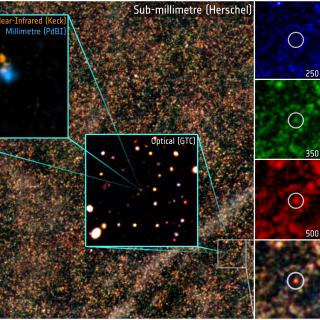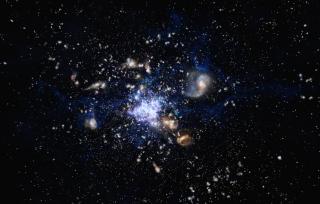Bibcode
Bakx, T. J. L. C.; Dannerbauer, H.; Frayer, D.; Eales, S. A.; Pérez-Fournon, I.; Cai, Z. -Y.; Clements, D. L.; De Zotti, G.; González-Nuevo, J.; Ivison, R. J.; Lapi, A.; Michałowski, M. J.; Negrello, M.; Serjeant, S.; Smith, M. W. L.; Temi, P.; Urquhart, S.; van der Werf, P.
Referencia bibliográfica
Monthly Notices of the Royal Astronomical Society
Fecha de publicación:
6
2020
Número de citas
23
Número de citas referidas
19
Descripción
Using the Eight MIxer Receiver (EMIR) instrument on the Institut de RadioAstronomie Millimétrique (IRAM) 30-m telescope, we conducted a spectroscopic redshift search of seven zphot ∼ 4 submillimetre bright galaxies selected from the Herschel Bright Sources sample with fluxes at 500 μm greater than 80 mJy. For four sources, we obtained spectroscopic redshifts between 3.4 < z < 4.1 through the detection of multiple CO-spectral lines with J ≥ 3. Later, we detected low-J transitions for two of these sources with the Green Bank Telescope including the CO(1─0) transition. For the remaining three sources, more data are needed to determine the spectroscopic redshift unambiguously. The measured CO luminosities and line widths suggest that all these sources are gravitationally lensed. These observations demonstrate that the 2 mm window is indispensable to confirm robust spectroscopic redshifts for z < 4 sources. Finally, we present an efficient graphical method to correctly identify spectroscopic redshifts.
Proyectos relacionados

Formación y Evolución de Galaxias: Observaciones Infrarrojas y en otras Longitudes de Onda
Este grupo desarrolla varios proyectos extragalácticos en diferentes rangos del espectro electromagnético utilizando satélites y telescopios en tierra para estudiar la evolución cosmológica de las galaxias y el origen de la actividad nuclear en galaxias activas. En el aspecto instrumental, el grupo forma parte del consorcio internacional que ha
Ismael
Pérez Fournon

Gas Molecular y Polvo en Galacias através del Tiempo Cósmico
Dos cuestiones fundamentales en la Astrofísica son la conversión de gas molecuar en estrellas y cómo este proceso físico depende del entorno en todas las escalas, desde sistemas planetarios, cúmulos estelares, galaxias hasta cúmulos de galaxias. El objectivo principal de este proyecto es el de estudiar la formación y evolución de galaxias a partir
Helmut
Dannerbauer